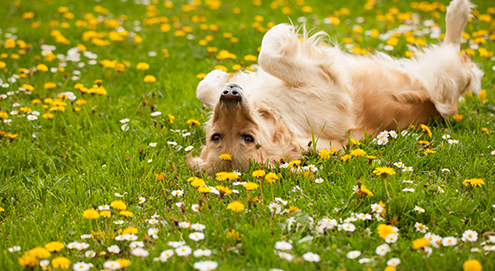Protecting your dog’s surgical wound
Written by Tommy |
Almost every dog will have to go through surgery at least once in his life. This can be a routine surgery, like spaying or neutering. But it can also be a less common surgery, like a knee operation or an operation to treat an ear hematoma.

How do you prevent your dog from licking the surgical wound? What methods are there and how are these used? In this blog we discuss several medical supplies you may need.
Protective shirts
A commonly used product to prevent your dog from licking, biting or scratching his surgical wound is a protective shirt. These exist in all sorts and sizes. Let’s take a closer look.
A medical dog suit
This is the most common protective shirt for dogs. Examples are the Medical Pet Shirt Dog or the Recovery Suit. These shirts are made to cover your dog’s entire body, from neck to tail. The head, legs and tail remain uncovered.
These shirts are most suitable for after surgery to the belly or spaying/neutering, but can also be used to protect other wounds in the belly or chest area. They can even be used to protect your interior when your female dog is in heat. The shirts are elastic, have a comfortable fit and don’t restrict movement. Unsnapping the suit and rolling it up allows your dog to do his needs during walks. Some shirt even allow for wound compresses to be put in, to absorb possible exudate.
A protective top shirt
Top shirts are meant to solely protect your dog’s chest. It’s mainly used after surgery or for wounds in the chest area.
Tightening these shirts also turns them into a type of swaddle. Swaddling has a calming effect on dogs and can reduce anxiety. Examples of these shirts are the MPS-TOP Shirt 4 in 1 or the Thundershirt. The latter is not meant for the protection of wounds, but solely for the anxiety-reducing effect of swaddling.
The MPS-TOP Shirt 4 in 1 has an equipment holder for a portable IV drip and can also be used to keep the MPS-HLS Hind Leg Sleeves in place.
Leg protection for your dog
- The MPS-TAZ2 Front Leg Sleeves, protects both your dog’s front legs
- The MPS-TAZ Protective Sleeve, protects one of your dog’s front legs
- The MPS-HLS Hind Leg Sleeves, protects your dog’s hind legs. Only usable in combination with the MPS TOP Shirt 4 in 1.
The paws can be protected with special paw protection products, like shoes, socks and boots. For wound protection you can use the Trixie Protective Sock and the Medical Pet Shirt Boot. These can also be used to keep bandages on the paws dry and clean.
Head protection for your dog
The last type of protective gear for dogs is head protection, or the MPS Head Cover. The Head Cover is specifically designed for dogs that need to have ear surgery or are being treated for an ear hematoma. The head cover keeps the ears flat against the head and protects against trauma caused by head shaking.
When to use protective shirts?
Protective shirts are meant for dogs that aren’t allowed to bite, lick and scratch a certain area of the body, usually a surgical wound. They can also be used to protect a hotspot or a different type of wound.
It’s important to choose the right size for your dog, so it fits snuggly and can do what it’s supposed to do. A shirt that’s too tight can irritate your dog or feel uncomfortable. A shirt that’s too loose may allow your dog to bite or scratch anyway.
How long should your dog wear a protective shirt?
How long your dog should wear a protective shirt depends on why he’s wearing it in the first place. A surgical wound is usually sufficiently healed after 14 days, which is usually when the stitches are removed. Some dogs never lick their surgery wound and will only need a protective shirt for 2 or 3 days or not at all. Other dogs continually want to lick their surgical wound and will need the shirt for a couple more days even after the stitches are removed.
How do I help my dog get used to a protective shirt?
Some dogs may need some time to get used to a protective shirt. They may contour their body every which way trying to get the shirt off or think they can’t move anymore. Don’t be tempted to take it off immediately, but allow your dog to get used to it. If it takes longer than 30-60 minutes for your dog to settle down you may need to look at different types of protection, like a protective cone.
Do you have any questions? Contact us at veterinarian@vetsend.co.uk.



